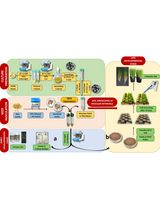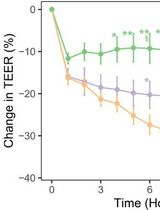- EN - English
- CN - 中文
A Retro-orbital Sinus Injection Mouse Model to Study Early Events and Reorganization of the Astrocytic Network during Pneumococcal Meningitis
用于研究肺炎球菌脑膜炎期间星形胶质细胞网络的早期事件和重组的眶后窦注射小鼠模型
发布: 2021年12月05日第11卷第23期 DOI: 10.21769/BioProtoc.4242 浏览次数: 3242
评审: Alexandros AlexandratosAllan-Hermann PoolAnonymous reviewer(s)
Abstract
Pneumococcal (PN) meningitis is a life-threatening disease with high mortality rates that leads to permanent neurological sequelae. Studies of the process of bacterial crossing of the blood brain barrier (BBB) are hampered by the lack of relevant in vitro and in vivo models of meningitis that recapitulate the human disease. PN meningitis involves bacterial access to the bloodstream preceding translocation across the BBB. A large number of PN meningitis models have been developed in mice, with intravenous administration via the lateral tail vein representing the main way to study BBB crossing by PN. While in humans, meningitis is not always associated with bacteremia, PN meningitis after intravenous injection in mice usually develops following sustained and very high bacteremic titers. High grade bacteremia, however, is known to favor inflammation and BBB permeabilization, thereby increasing PN translocation across the BBB and associated damages. Therefore, specific processes associated with early events of PN translocation may be blurred by overall changes in the inflammatory environment and potentially systemic dysfunction in the case of severe sepsis. Here, we report a mouse meningitis model induced by PN injection in the retro-orbital (RO) sinus. We show that, in this model, mice appear to control bacteremic levels during the first 13 h post-infection, while PN crossing of the BBB can be clearly detected by fluorescence confocal microscopy analysis of brain slices as early as 6 h post-infection. Because of the low frequency of events, however, PN translocation across brain parenchymal vessels at early time points requires a rigorous and systematic examination of the brain volume.
Background
Bacterial meningitis is a severe disease with high mortality rates and life-long neuropsychological sequelae for survivors. Its incidence is particularly high in low/moderate resources countries (GBD 2016 Meningitis Collaborators, 2018). Only a limited number of bacterial species cause meningitis, with Haemophilus influenza type b, Neisseria meningitidis (meningococcus), and Streptococcus pneumoniae (pneumococcus) accounting for the large majority of cases.
Pneumococcus (PN) is a human nasopharyngeal commensal and major bacterial pathogen responsible for invasive diseases (IDs). Its high genomic plasticity accounts for the large number of identified serotypes (>96), with only a minority (<13) associated with invasive diseases such as bacteremia, cellulitis, pneumonia, or meningitis. PN is the main causative agent of community-acquired meningitis, which has high morbidity and mortality worldwide (Mook-Kanamori et al., 2011). Despite the characterization of the role of several PN virulence determinants, the mechanism underlying PN crossing of the BBB remains poorly understood. In particular, among the large number of serotypes, it remains unclear why a limited subset is more frequently associated with meningitis (Kulohoma et al., 2015). PN meningitis is believed to follow bacterial translocation across the nasopharyngeal epithelium and access to the blood stream for sustained periods of time (Iovino et al., 2013).
Despite the recent development of in vitro BBB models, a major hurdle remains with the lack of in vitro systems that faithfully recapitulate the BBB properties (Abbott et al., 2010; Abbott and Friedman, 2012; Sonar and Lal et al., 2018). This is largely due to the barrier itself, implicating endothelium interplay with astrocytes, mural cells (pericytes and vascular smooth muscle cells), and neurons. Indeed, the barrier “mechanical” properties are conferred by endothelial cells from the brain vasculature forming tightly sealed intercellular junctions, with low and regulated endocytic activity. However, endothelial permeability is controlled by the interaction of astrocytes, via processes called endfeet contacting the perivascular space surrounding intra-parenchymal brain vessels, through the secretion of cytokines and other chemical factors, such as TGF-β, or IL-6 (Abbott and Friedman, 2012). Neurons and pericytes also control endothelial trans-cellular permeability by regulating BBB gene transcription and by promoting astrocyte endfeet polarization around blood vessels (Armulik et al., 2010). In addition, through mechano-sensitive signaling, shear stress induced by blood flow promotes the up-regulation of endothelial intercellular components and transporters required for BBB function (Cucullo et al., 2011). Finally, the cytokinic and inflammatory environment regulated by immune cells locally recruited at infectious sites plays a critical role in BBB permeability (Sonar and Lal et al., 2018). Specifically, microglial cells, acting as a first line of defense, play a key role in controlling infection but may also contribute to BBB permeabilization during systemic inflammation (Gres et al., 2019; Haruwaka et al., 2019). In light of all these considerations, the gold standard to study BBB crossing by pathogens currently remain in vivo models with a stable genetic background, such as inbred mice.
Balb/c and C57/BL6, the main mouse models used in infection studies, show different sensitivity to PN infections and PN clones (Sandgren et al., 2005; Jeong et al., 2011). Presumably, because of their weaker Th1-response, Balb/C mice are more sensitive than C57/BL6 mice to systemic PN infections and have been used in various PN meningitis models (Sandgren et al., 2005; Grandgirard et al., 2007; Jeong et al., 2011). Among the various mouse models of PN meningitis, intracranial injection of bacteria in the subarachnoidal space cannot be considered to study PN translocation across the BBB. Other models involve means to fragilize the BBB (e.g., hyaluronidase injection and promoting inflammation) that may alter invasion routes, or cochlear implants leading to PN spreading to the middle, inner ear, and then CSF. PN meningitis models triggered following intraperitoneal or intranasal injection have also been used. Intravenous injection via lateral tail veins remains a method of choice to trigger PN meningitis, but requires skills and practice. To overcome the drastic bacterial clearance mediated by neutrophils and splenic macrophages during the first hours of infection, a sufficient inoculum needs to be administered intravenously while not exceeding the dose that will trigger septic shock, usually between 107-108 equivalent CFUs (Gerlini et al., 2014). In all aforementioned methods, meningitis occurs following sustained high bacteremic titers (> 106 CFUs/ml) not always observed in human diseases (Shahum et al., 2007), questioning the links between meningitis and major dysfunctions associated with sepsis in these models.
Intravenous administration by injection in the mouse retra-orbital (RO) sinus was first introduced about 15 years ago as a convenient alternative for tail vein injection and is now routinely used (Yardeni et al., 2011). While it was also used for the intravenous administration of pathogens or toxins, its use to induce bacterial meningitis had not been described previously to our recent works (Bello et al., 2020). Potential leakage from the RO sinus or local inflammation linked to the injection procedure is unlikely because RO injection has been routinely used in studies assessing BBB permeability to various compounds (Zuluaga-Ramirez et al., 2015). Here, we described administration via the RO sinus as a robust and reproducible model to study early events during PN meningitis. Following RO injection, mice reproducibly developed PN meningitis associated with endothelial and systemic inflammation, while showing controlled bacteremic titers (Bello et al., 2020). Interestingly, the bacteremia dynamics appeared to differ from those described for tail vein injection. RO injection of 107 CFU-equivalent leads to sustained bacteremic titers (ca. 104-105 CFUs/ml) during the first 13 h post-infection. An abrupt increase to up to 108 CFUs/ml after 24 h post-infection may be observed, which likely corresponds to secondary infection from infected organs and systemic failure (Bello et al., 2020). These results suggest that, as opposed to tail vein injection, bacteria injected in the RO sinus are not rapidly diluted in the bloodstream, but steadily released from the retro-orbital sinus during the first hours of infection.
Specifically, this model enables the visualization of early events of PN translocation across brain parenchymal vessels and its effects on astrocytes. While in humans, PN rarely causes encephalitis or meningoencephalitis, our studies indicate that PN translocation in the CSF occurs early and concomitantly with translocation across brain parenchymal vessels, indicating that this model could also be used to study the severe forms of PN meningoencephalitis associated with major brain injury. However, due to the low frequency of PN translocation in the brain at early time points (<6 h post-infection), its visualization by immunofluorescence microscopy requires the systematic analysis of brain slices, which we describe in this article.
Materials and Reagents
1.5 ml Eppendorf tubes safe-lock (Eppendorf, catalog number: 0030120086)
15 ml Falcon tubes (Dutscher, catalog number: 352095)
Mouse cages (Animalab, catalog number: 031200260)
0.3 ml Terumo Insulin syringes (Terumo, catalog number: 3BS30M2913)
Syringe needles Gauge 27, L ½ inch (Sigma-Aldrich, catalog number: Z192384)
Scalpels (Fisher Scientific, catalog number: 3120032)
Defibrinated sheep blood (Alliance-bio-expertise, catalog number: 23689)
Bacteriological agar (Sigma-Aldrich, catalog number: A5306)
Todd Hewitt medium (ThermoFisher, catalog number: BD249240)
Yeast extract (ThermoFisher, catalog number: 210929)
Phosphate Buffer Saline (PBS)
OCT cryoembedding matrix (Fisher Scientific, catalog number: 23-730-625)
Isopentane (Sigma-Aldrich, catalog number: PHR1661)
Paraformaldehyde (Merck, catalog number: 158127)
Ethanol (Merck, catalog number: 493511)
Goat serum (Sigma-Aldrich, catalog number: G9023)
Triton X-100 (Merck, catalog number: X100)
Ketamine (Merck, catalog number: Y0000450)
Xylazine (Merck, catalog number: 46995)
DAKO (DAKO, catalog number: 83023)
Trizol (Invitrogen, Life Technologies, catalog number: 15596026)
Strains:
Wild-type serotype 4 Streptococcus pneumoniae TIGR4 (ATCC, catalog number: BAA-334TM)
C57/BL6 6-8-week-old male mice (Charles River)
Antibodies:
Anti-PN capsular rabbit polyclonal antibody (Statens Serum Institute, Copenhagen, Denmark).
Anti-GFAP mouse monoclonal antibody (ThermoFisher, catalog number: G3893)
AlexaFluor 563-conjugated isolectin IB4 (ThermoFisher, catalog number: A11029)
AlexaFluor 488-conjugated goat anti-mouse IgG (Life Technologies, catalog number: A11029)
AlexaFluor 555-conjugated goat anti-rabbit IgG (Life Technologies, catalog number: A11034/A21429)
6-Diamidino-2-phenylindole dihydrochloride (DAPI) (ThermoFisher, catalog number: D9542)
RNeasy Lipid Tissue kit (Qiagen, catalog number: 74804)
Superscript II reverse transcriptase kit (ThermoFisher, catalog number: 18064014)
SYBR green PCR master kit (ThermoFisher, catalog number: A46012)
Equipment
Biosafety level 2 laboratory
CO2 incubator (Sanyo, model: MCO-18AIC)
Spectrophotometer (WPA, Biowave)
Eppendorf centrifuge (Eppendorf, model: 5810)
Eppendorf centrifuge (Eppendorf, model: 5424)
Sterile hood (Telstar, Bio II A)
Peristaltic pump (Gilson, Minipuls Evolution)
4°C refrigerator (Liebherr, Comfort)
Nanodrop (Thermo Scientific, model: NanoDrop 2000)
PCR Light Cycler (Roche Life Science, model: LightCycler® 480)
Cryostat (Cryostar, model: NX70)
TissueLyser II (Qiagen, model: 85300)
-80°C freezer (Sanyo, model: MDF-U53V)
Inverted fluorescence microscope with motorized XYZ stage (Nikon, model: Eclipse Ti) equipped with a Plan Apo Lambda 60× objective /1.40 NA oil
Spinning disk confocal microscope (Roper Scientific) equipped with a Yokogawa CSU-W1 scanner unit, 405 nm, 100 mW – 491 nm, 150 mW – 561 nm, 50 mW – 642 nm, 25 mW lasers, and a C-MOS Camera (Andor, an ORCA-FlasH 4.0)
Software
Fiji
Microsoft Excel
Metamorph 7.7
Procedure
文章信息
版权信息
© 2021 The Authors; exclusive licensee Bio-protocol LLC.
如何引用
Bello, C., Cohen-Salmon, M. and Tran Van Nhieu, G. (2021). A Retro-orbital Sinus Injection Mouse Model to Study Early Events and Reorganization of the Astrocytic Network during Pneumococcal Meningitis . Bio-protocol 11(23): e4242. DOI: 10.21769/BioProtoc.4242.
分类
微生物学 > 体内实验模型 > 细菌
微生物学 > 微生物-宿主相互作用 > 细菌
生物科学 > 生物技术 > 微生物技术
您对这篇实验方法有问题吗?
在此处发布您的问题,我们将邀请本文作者来回答。同时,我们会将您的问题发布到Bio-protocol Exchange,以便寻求社区成员的帮助。
Share
Bluesky
X
Copy link












